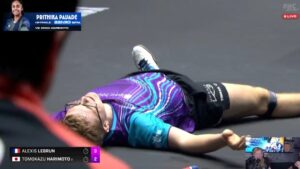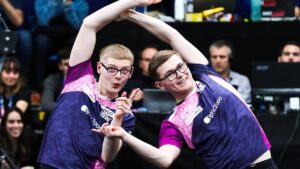
This is the novelty of this second edition of the WTT Champions of Montpellier: the training room is open to spectators. A 20 euro option – in addition to the ticket – with which the most curious can see the table tennis players in their pre-match routine or in the middle of a training session.
“It’s behind the scenes, it’s really nice to discover the sidelines,” breathes Stéphane, a table tennis player for 30 years. He, like several dozen curious people, took the training room option during the WTT Champions in Montpellier, which brings together this week some of the best table tennis players in the world in Hérault.
A paid option. For 20 euros more when purchasing a ticket for a session, it is possible to see the players warming up and training. “We had a thought at the end of last year's edition about the fact that we could bring a little extra to the training room. And we said to ourselves why not bring in spectators, that could be very good,” explains Franck Saulnier, the manager of the training room.
If it is a novelty in France, it is not on the WTT circuit. In Asia, all training sessions are open and fans rush to the front row, with big cameras, and machine-gun the players in all directions. Here, in Montpellier, the rules are different: 150 seats only, ban on taking photos or videos, and obligation to remain silent. “For the moment I want to say that it's pretty well done. People are nice on that aspect. They understood that in terms of regulations it was like that. So we don't have any overflow,” underlines Saulnier.
“I didn’t know that the players played between different nationalities”
Thursday, a few hours before the clash between Félix Lebrun and Simon Gauzy, in this area at the back of the room which contains 12 tables, the excitement was at its maximum. Most of the chairs were taken by the public, most of them connoisseurs. “It’s a great opportunity to be so close to them, to see them more relaxed,” says Romain, who came with a friend, with a big smile.
“It’s good to see their environment, their cocoon too before entering a match, it’s not bad,” adds Sébastien.
“I didn’t know that the players played between different nationalities,” discovers Romain. Indeed, at that moment, Flavien Coton, the 17-year-old Frenchman, was warming up Lin Yun-Ju, the Taiwanese table tennis player. Timéo and Loan have their eyes glued to the tables. Both are young players. “I wanted to see them up close, and see their level. So yes we see them on television, but seeing them in real life is better,” smiles Timéo. “There they play baskets of balls, in normal distribution. They warm up by doing game systems,” analyzes Timéo.
After training by Alexis Lebrun, it was the French coach, Nathanaël Molin, who went to see the spectators. Some had rackets to sign and were able to exchange a few words with him. “These are people for whom I am grateful, they come to watch our sport and support us in this magnificent room. I know that they support us a lot behind the screen. I just thanked them for being there. I think it is also important that we give this time to people”, slips the technician.
Alexis Lebrun: “I would have loved to see that before going there so I think it’s cool”
Even if he is used to tournaments in Asia, Alexis Lebrun finds this initiative very good. “It's more pleasant in France because they don't have the big cameras. But it's always a pleasure, it puts a bit of atmosphere in the room whether it's in China or here. It doesn't bother me at all. I find it nice for the fans to see the warm-up room. I would have liked to see that before being there so I think it's cool.”
Nathanaël Molin adds: “It's not disturbing for the players either. And at the same time, people can enjoy it. It shouldn't be more, because the players also need to be able to breathe and not be in the spotlight all the time. When we want to feed on this positive energy, we'll perhaps take a training table closer to them. And when we want to work on things that are perhaps a little more confidential or that the players simply need to be more calm, we are going to stand a little further away in the room.”
In any case, it is a novelty which should continue in future editions. “I think we will continue to do it. I will go see the public, to get their impressions. And then also for us, to see what we could possibly do for them in addition, if they appreciated it,” emphasizes Franck Saulnier.




